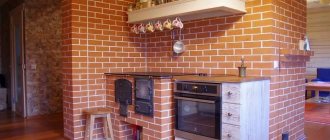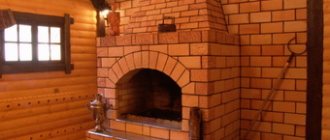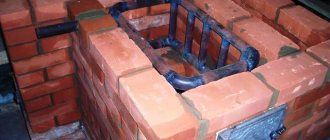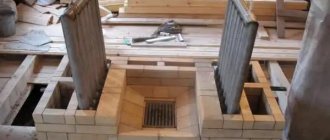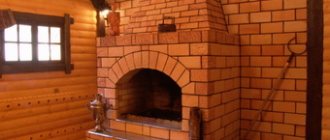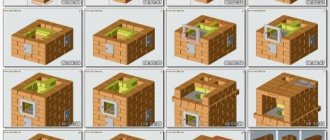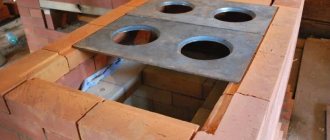If you want to have a beautiful brick stove at your dacha, then in this article we have collected useful information on its design - indicating the necessary materials and existing schemes. You will learn how to build the simplest brick stove with your own hands for a summer residence and get an excellent, durable result. Thanks to such a simple but useful device, you can cook various foods and use it as a heating element.
Heating stove with hob Source zemeljka.ru
Furnace designs
Brick kilns have not lost their relevance in the private sector for many years. This is due to their economy and efficiency. The thick walls of the structure can retain heat for a long time.
Stoves are distinguished by purpose and are heating, cooking, combined and multifunctional. We will describe each variety below.
For heating
The most common and simplest. Used for heating only. It is mainly used in houses remote from gas pipelines. It is also often installed as a fireplace stove. These include fireplaces that can have a closed or open firebox, which can effectively heat up to 20 m² of space. Includes a combustion chamber (can be laid out or purchased separately), an ash pan and a chimney.
Stove-fireplace in the country Source pechnoy.guru
Heat transfer depends on the type of masonry, the size of the walls and the materials used. The most popular masonry option is one brick. The walls warm up to 600 degrees. The shape can be elongated, wide, round, triangular. The choice of shape depends on the desires of the home owner, the interior and the area of the room itself. Stone, plaster and tiles are used for decoration.
The easiest way is to make a rectangular or square oven. All other options should be entrusted to a good specialist, since there are many nuances and features of masonry that should always be remembered. To increase the tightness, the stove can be equipped with sheet metal on the outside, which makes it possible to heat large houses.
With hob
A good choice for a summer house that is used in warm weather. The emphasis is not on heating, but on the convenience of cooking. Additionally, a tank for heating water can be installed, which ensures comfortable living. Widely used in homes with heating by electricity or natural gas. The building is made of brick, inside the structure there is a chimney, an ash pit and a firebox. Place a stove on top, you can make an oven.
Option with hob and built-in oven Source gost-kamin.ru
Combined models
Used for cooking and heating at the same time. The project is much more complicated than the previous ones, since it is necessary to make an ash pit, a fuel combustion chamber, a chimney, install a cabinet and a hob. This option is quite heavy and massive, so it is used for spacious houses that require a solid foundation. Used if there is no other heating method. Sometimes they are equipped with drying chambers for preparing various preparations, clothes, and firewood. They are also often equipped with water tanks, beds, and ovens.
Combined stove in the gazebo Source avatars.mds.yandex.net
Multifunction ovens
They are mostly done only in large gazebos. They simultaneously heat the structure and allow you to cook food. As in the previous case, they can have an oven and dryer. The main difference between these ovens is that they can additionally have several more sections for frying food over coals or smoking. Naturally, it is simply impossible to make such a stove yourself without the appropriate skills and knowledge. Therefore, trust the work to qualified craftsmen with extensive experience. This is the only way you will get a good result that will always please you.
Construction, material base
A traditional Russian stove is a massive stone structure of intermittent operation, heating and cooking type, equipped with a stove bench.
Thanks to its high heat capacity, the stove accumulates heat and releases it into the room for a long time after heating. Therefore, the room does not get cold, even if it is not possible to continuously maintain the fire. The standard dimensions of a Russian stove were tied to arshins, but when converted to the usual centimeters they are usually rounded.
- Length – 3 arshins (about 213 cm, now 210 cm).
- Width – 2 arshins (about 142 cm, now 140 cm).
- The height to the bed is 2.5 arshins (about 178 cm, now 180 cm).
A Russian stove of this size could heat a room of about 40 m². With the use of modern energy saving technologies, this area can be significantly increased. What then, what now, the shape can be whatever you want, but the design of the classic Russian stove is unchanged.
- Ward - a foundation (stone, brick, concrete, wood); if the guard was wooden, it was combined with an under-furnace.
- Podpechek (podpechok) - a cavity under the stove intended for storing and drying fuel.
- The hearth (vault) is the base of the furnace, insulated with backfill (sand, brick chips, expanded clay), which ensures optimal temperature in the cooking/oven zone.
- A stove is a small cavity for storing dishes, if located in the front part, it is called a subrack.
- The shelf is a platform in front of the furnace, where cooked food is left after being removed from the oven.
- Under – the base of the cooking zone, is made with a slight slope forward (so that the gases collect under the arch, and it is more convenient to move the dishes).
- The crucible (cooking zone, firebox) - fuel combustion and food preparation take place in it.
- The vault (sky) is the upper part of the furnace, rectangular, arched or barrel-shaped, with a backfill on top to prevent direct heating of the stove bed.
- A bed (floor, roof) is a platform above the furnace, intended for resting or sleeping, one of the main elements of the classical design.
- Overpipe - the top, a chamber above the pole, ending with a tapering nozzle (hail), in which smoke collects, giving off heat to the house before being discharged into the chimney.
- View - a valve with a hole above the hilum, located behind the door, through which the flow of cold air from the pipe is regulated.
- Pipe (chimney).
- The valve is located in the pipe, above the view, and allows you to completely close the chimney.
And an example of a stove with a stone base.
In the classic version, Russian stoves are bell-type structures with a channelless convective system. Since the heat source is located almost a meter high from the floor, and in the oven there are not only no channels, but it is also insulated, the temperature difference in the room can be more than ten degrees. In modern stoves used for cooking and heating, this problem is solved by installing chimneys instead of ovens, ensuring uniform heating of the room at all levels. And there can be several fireboxes, depending on the required functionality.
Increasingly, outdoor complexes are being built on the basis of Russian stoves, the main task of which is to prepare dishes in various modes. These stoves no longer have a bench, they are much smaller in size, and to maintain the temperature in the cooking zone as efficiently as possible during construction, thermal insulation materials are used.
Another modification is to make a small firebox under the hearth so that you can cook in the warm season without having to heat the entire oven and room. Often in such ovens, the firebox above the firebox is equipped with grates to create a barbecue, or a metal hob is installed.
As for the masonry material, the best option is a special oven brick designed for high heat. But structures made of red solid brick, in combination with fireclay in the area of the firebox and mouths, are also quite viable.
The main condition is that the brick must be of high quality, not burnt, with a smooth surface and good geometry, since the seams are thin and it will not be possible to play with mortar.
There are decorative bricks with chamfers and arched ones on sale, but many process ordinary bricks - both economically and manually.
Today there are no problems with various specialized masonry mortars, although our predecessors got by just fine with mixtures based on fatty clay and river sand. Before use, the clay was thoroughly crushed and sifted, and the sifted sand was calcined. The proportions varied - either sand and clay in equal parts, and water one part of the volume, or more sand (up to five parts). Since difficulties usually arise with the right clay, there are not only ready-made mixtures on sale, but also oven clay separately. A brick oven without further finishing also looks aesthetically pleasing, but if desired, it can be lined. Stoves plastered with clay and whitewashed will look organic only in an appropriately decorated room.
Simple and economical furnace laying
There are several options for how to build a brick oven with your own hands for a house with a stove, step by step and correctly. First of all, you must first determine what the main purpose of the structure is - heating or for cooking. You may choose an option with the additional elements listed above or a direct-flow design. The main thing in resolving this issue is the purpose of the future design.
Design of a small stove Source avatars.mds.yandex.net
Designs with weak gas revolutions do not provide high heat transfer. They are mainly used for small areas - up to 16 m² and garages.
With hob
How to make a stove of this type is described below. The simplest model is small in size - 78x53 cm (WxD) and allows you to place one burner. You can use red brick, but it must be selected very carefully - only smooth and without cracks. This will save on the purchase of fireproof stones.
For the solution, take clay/water/sand (4/1/8 hours). The amount of mortar is determined in accordance with the amount of brick. If the seam is 3-5 mm, then it will be enough for 50 pieces. stones.
The process of laying a slightly smaller stove is as follows:
- A base is prepared that is approximately 10 cm wider than the future structure; the first brick on the base is placed at floor level. With an underground of 0.5 m or more, a hole is not needed.
- Formwork is made 74x61 cm, roofing material is placed on top (in two layers) and concrete is poured. Construction of the structure begins in 7 days and not earlier. It is necessary that the foundation dries well, otherwise the structure will simply sag, may tilt and crack.
Foundation for a stove Source bricks.su
- The depth of the structure is 3 stones, the width is half as much - 1.5 (76x39 cm). The stones are adjusted first without mortar. The layer of mortar for the bottom row is no more than 5 mm.
- On the next tier a hole is left for the blower door. Fastening occurs with wire, its ends are laid in the seams. They leave a gap between the metal and the stone.
- 4 tiers of stones are laid on edge, a firebox is created, and a smoke circulation is created at the back. One stone is placed at the back without using mortar; it must be removed to clean the chamber. Two stands are made in the chimney; they hold the partitions.
- The 5th row is laid flat, leaving a hole for the door, there will be channels at the back.
- From the 8th the door is closed. A brick with a beveled end is placed in the back of the firebox.
- After the 9th tier, a cord (asbestos) is laid, it is used as a sealing material for joints.
- On the 10th, the firebox is covered with a stove.
- Row 11, a valve is placed in the pipe, the pipe is sealed with a cord.
On the next 2 tiers the walls of the pipe are made. How to build a brick oven with your own hands for a house with a small stove - stick to this design and everything will work out. But we must remember that there are a number of nuances and emerging difficulties that need to be resolved immediately. If you make mistakes, you will not get the desired result. Therefore, it is better to contact a specialist.
Laying a square stove with bottom heating
The stove in the photo has a combined or mixed smoke circulation system. The parameters of this design are 102x102x238 centimeters. Its heat output is 4200 kcal/hour. The design of square-shaped heating stoves with bottom heating suggests that the firebox in it has a relatively large height. Side openings located symmetrically on both sides (2 pieces each) serve to drain gas into the chambers. They are located in the outer side walls of the structure. The gas then descends through chambers connected by a channel under the firebox behind the ash compartment.
From the side chambers, gases enter the risers through the lower ports and rise upward along them. There, the side chambers all together form the so-called upper cap, which consists of three U-shaped cavities. These cavities are located parallel. The heated gases are retained in the upper part of the middle and rear of them, and the already cooled waste products pass through the holes into the front plane, which at the top is connected to the mounted smoke exhaust pipe and evaporate into the atmosphere. Read also: “Heating stoves under development.”
Consequently, the diagrams of stoves for a square-shaped house with bottom heating include 3 hoods - an upper hood and 2 large chambers. In such a heating structure, any type of solid fuel can be used.
If it is planned that the stove will operate on hard coal or anthracite, the walls of the firebox should be laid exclusively from refractory bricks.
Video description
How to lay a small stove, watch the video:
Direct flow type
There is nothing particularly difficult about how to make a direct-flow furnace. But it is very important to strictly adhere to all requirements and be sure to choose a quality stone.
Used for heating small rooms. A strong foundation is needed. Design dimensions 51x64 cm (WxD).
The arrangement of the furnace is as follows:
- For the foundation, crushed stone is poured into a layer of up to 20 cm and filled with mortar. Each stage must be carefully aligned. You can lay the stone only after a few days.
- The depth of the structure is 2.5 stones, the width is 2. There is no blower chamber; instead, holes are drilled in the door.
- Only the 6th row will cover the door. The general procedure is very simple, you just need to observe the dressing.
- From the 8th row, the structure is narrowed using halves of ¾ pieces of stone. Firebox outlet 12.5x25 cm.
- The 9th row is laid with a whole brick, similar to the 7th.
Laying a direct-flow furnace Source blog-potolok.ru
- The next row is placed edge flush with the inner edge.
- Then again, flat (4 pcs. ¾ and 2 pcs. whole), narrowing the smoke channel.
- Next, the stones are edge-on, there is a brick in the middle of the channel, the structure rises 5 tiers.
All other channels are laid flat. On the last 2, the channel is narrowed in halves to dimensions of 12x12 cm. The valve and pipe are installed last.
See also: Catalog of companies that specialize in the installation of stoves and fireplaces, grill houses and gazebos.
For heating
Let's look at how to build a brick stove for heating. For example, let's take a stove 51cm x 90cm x 2m 38cm (WxDxH).
The following materials will be required:
- sand/clay/brick (18/9 buckets/390 pieces, red, solid);
- doors (cleaning and blowing doors);
- roll of waterproofing roofing felt (60cm x 1m);
- one valve and grid 40x25 cm;
- one pre-furnace steel sheet 70x50 cm.
Brick stove-fireplace for heating Source svoimirukami.lesstroy.net
The masonry process is as follows:
- The base protruding in the first row is laid. Be sure to check the horizontal level with a level. The hardest thing to work with is the corners. It is recommended to install template posts at the corners from bottom to top.
- Two stones with beveled edges are placed at the end.
- The air vent door is installed and secured.
- On the next 2 tiers an ash chamber is made.
- The fire chamber is laid out and a grate is installed.
- The firebox door is placed from the 7th to 8th tiers, beveled bricks are placed at the back (they improve the draft inside the stove).
- At 9 the firebox door is closed.
- The smoke exhaust and fuel chamber are placed from rows 10 to 16.
- The cleaning door is installed on the 17th row.
- Smoke circulation channels are made on 18-30 rows. The walls must be smooth; the inside of the walls must be rubbed with a wet rag.
- On the next two tiers, the roof of the furnace is made.
- The last 2 tiers are laid out for the chimney.
Laying a heating stove Source eurolain.ru
How to make a brick stove for your home with your own hands, if the room is small, is described above. The main thing is to adhere to all requirements and rules. Upon completion of the masonry, the structure must be left to dry. After seven days, a test fire is required.
Economical option
If your budget is limited and the room itself is small, then such a design will be a real salvation. There are many fairly simple designs for economical stoves. You can try making them yourself or order installation. But in any case, you need to understand how to lay a brick stove with your own hands. Even if you don’t do the masonry yourself, knowing how to build a stove will allow you to control all the work.
Heating stove Source i.ytimg.com
The process of building a small stove
At the initial stage, preparatory work is always carried out. The quality of construction of a small brick stove for a summer cottage largely depends on them.
Project selection
When contacting professionals, you can choose one of the ready-made stove designs. Highly qualified specialists will also, if necessary, develop individual drawings taking into account the customer’s wishes. When choosing a specific option, consider:
- heated area;
- number of heated rooms;
- winter air temperature outside;
- purpose of a small stove;
- heater heating frequency;
- construction costs.
When choosing a furnace design, construction costs are taken into account Source ark-eng.ru
Video description
For a clear overview of laying and applying mortar, watch the video:
- Duplicate row, but the stones are laid flat.
- The brick is on edge, the walls are wiped with a wet rag.
- The brick is laid flat, and on the back side - on the edge.
- Next, the firebox is closed, 2 bricks should hang over the chamber (if the structure is planned to be used as a fireplace and the firebox is not covered), the flame will be directed to the middle of the structure.
- The stones are moved a little to the back side, they will support the door. Before laying the brick, wet strips of asbestos are laid to seal it. The panel cannot be placed on the mortar - cracks will appear due to the difference in thermal expansion.
- A pipe is formed to remove smoke. A smooth expansion is made towards the back. Stone is used for the base; light metal is used for everything else.
- A valve is installed, it is necessarily sealed with asbestos, first coated with a solution. This completes the construction of the structure.
Decorated stove for cooking and heating Source mainavi.ru
At the end, several tiers of the chimney are made, and a pipe is inserted into it. The brick (installed without mortar) and all debris are removed. The joint of the structure near the floor is closed for decoration with metal. The structure will dry completely after 1-2 weeks.
How to build a simpler type of oven if you don’t have the time, necessary materials or skills? Take advantage of the following structure, which can be erected in just a few hours. It has the simplest operating principle.
Fuel is placed below, which burns there, and where it settles. The draft is created by temperature changes. This design is characterized by a minimal amount of smoke and almost complete combustion of fuel. For this option, two half stones and 20 whole bricks are enough. There are five rows in the stove, the stones are tied together with mortar, but you can lay out the stove without using it - it will be a temporary structure.
Preparation for work
For laying a stove with a stove, different types of brick are used. Usually they take solid red for the outer masonry and fireclay for the inner lining of the firebox, as well as the smoke well.
The foundation is poured with concrete mortar. To prepare it, you will need cement of at least M400, preferably M500. The sand can be river or from a quarry, but it must first be sifted to prevent the ingress of impurities. Clean water should also be used. For the solution, you should also take granite crushed stone about 30 mm.
The foundation is backfilled using rubble granite, a suitable fraction is approximately 300 mm. In addition, you will need to prepare a solution of red clay and sand.
Instead of clay, you can purchase clay powder; the instructions for using it are indicated on the package. All components must be of good quality; the integrity and service life of the future stove depends on this. To seal the joints, you need to prepare a high-temperature sealant.
The work is carried out using ordinary construction tools.
You may need:
- containers for mixing the solution;
- Master OK;
- Bulgarian;
- plumb line;
- level;
- roulette;
- rule;
- mallet;
- furnace hammer;
- other devices for processing and laying bricks.
To make a high-quality solution, it is better to use a hammer drill or drill with the appropriate characteristics, as well as an attachment designed for these purposes. A shovel and a sieve will come in handy.
Advantages of a simple stove
All simple type ovens have many unique advantages. For example, a minimum of time is spent on their construction. Some models can be erected in just an hour, while others take 1-2 days to install. Small structures are lightweight, which means they do not require a foundation, which saves time, money and effort. You can choose any place to install the structure; if mobile versions are made without using a binder solution, then it can be disassembled at any time, moved and installed in a new location. Any materials can be used for fuel - pine cones, logs, stems of large plants, and so on.
Option for decorating a fireplace stove Source o-remonte.com
It is also important that such designs have lower fuel cell consumption. For example, compared to potbelly stoves, you will need several times less firewood. If you use the simplest stove without binding stones with clay, you can increase the heat transfer, which will be greater than from an open fire. This is a great option for hiking, but not very convenient if you travel without transport. Since the brick is heavy and capacious, it is inconvenient and difficult to carry.
An additional big advantage is the minimal level of smoke, and the fuel itself practically burns without waste. After good heating, the temperature of the stones can reach 1 thousand degrees, which guarantees not only good and fast heating, but also quick cooking of various dishes.
The nuances of finishing the stove
The walls of the stove, made of good brick, and even decorated on the outside, do not need to be finished: whitewashed and plastered. If there are no chips or cracks on the masonry elements, and the verticals and horizontals were observed during construction, the heating structure will still look great.
On stove masonry made of high-quality brick, it is enough to grout and carefully unstitch the seams. Without unnecessary finishing, the heating and cooking structure looks better.
If there are still complaints about the stove walls, there are defects on them, and the masonry is not ideal, then finishing is very necessary. Before finishing work, the outer surface is thoroughly mopped, rubbed with a piece of brick to improve adhesion, and then wait for it to dry.
The dried unit can be plastered using the clay-sand mortar used in the masonry. To increase strength, it is possible to add 1% asbestos chips to the composition. Heating options for stoves are lined with tiles - this is the most reliable and gas-tight, but also the most labor-intensive type of finishing.
Image gallery
Photo from
Whitewashing is a typical type of finishing
Combination of whitewash with cladding
Budget cladding with regular tiles
Luxurious cladding with spectacular tiles
Do you need a drawing?
Drawings “how to build a stove with your own hands correctly” are not required in this case, especially if a specialist is working. A clear and detailed description allows you to do without them. It is the simplicity of the designs and minimal costs that make it possible to save yourself from complex and lengthy work.
A high-quality and detailed drawing is only necessary if you are building a large stationary stove for heating your home and cooking food. But even in this case, an experienced specialist can do without it.
Multifunctional large oven Source i.ytimg.com
Conclusions and useful video on the topic
A visual demonstration of laying a brick stove will help you get familiar with the essence of the process:
Building a brick stove can hardly be called an easy task, but it is quite accessible for DIY. Guided by the manual and procedures we presented, you can build a perfectly functioning stove with your own hands. Information about the general rules for the construction of heating and cooking units will help control the work of hired stove builders.
If you have experience in laying brick ovens, please share it with our readers. Perhaps you know some subtleties that we did not mention in this material? Leave your comments in the contact block below.
